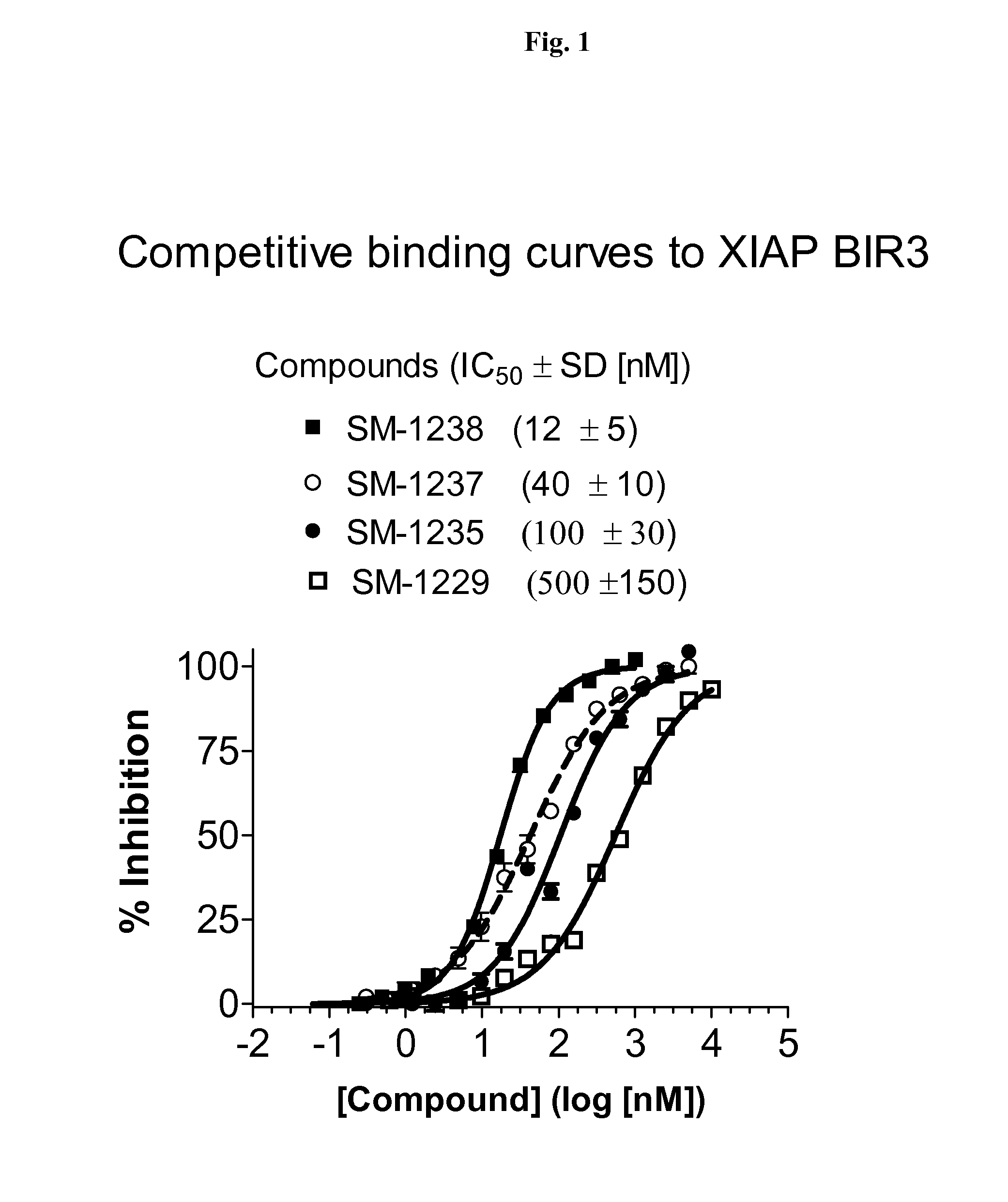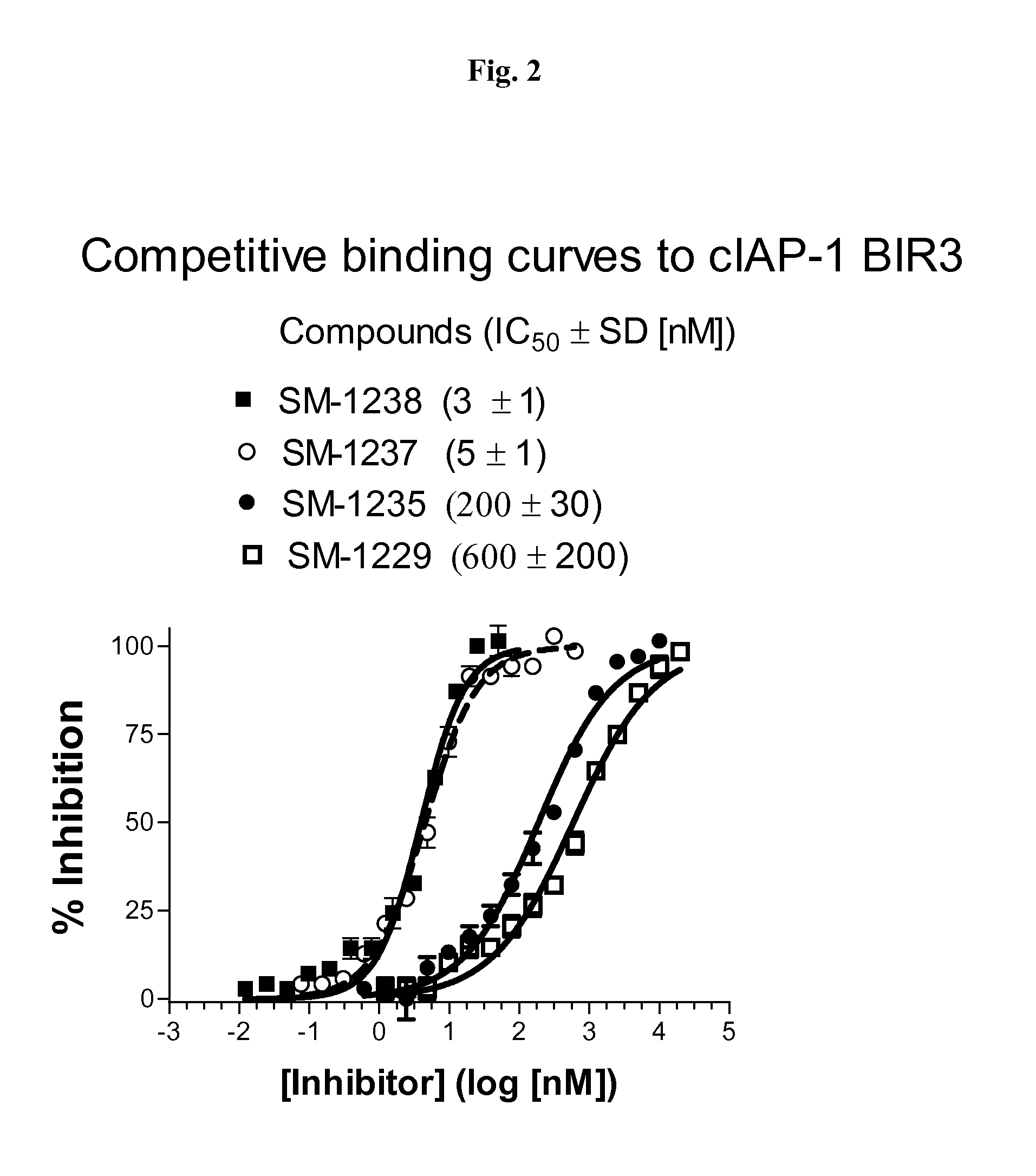Heteroaryl-substituted bicyclic smac mimetics and the uses thereof
a technology of heteroaryl-substituted bicyclic smac mimetics, which is applied in the field of medicinal chemistry, can solve the problems of poor cell permeability, poor in vivo stability, intrinsic limitations of peptide-based inhibitors as potentially useful therapeutic agents, etc., and achieve the effect of increasing expression
- Summary
- Abstract
- Description
- Claims
- Application Information
AI Technical Summary
Benefits of technology
Problems solved by technology
Method used
Image
Examples
example 1
Synthesis of Covalently Constrained Smac Mimetics
[0427]General Methods: NMR spectra were acquired at a proton frequency of 300 MHz. 1H chemical shifts are reported with Me4Si (0.00 ppm), CHCl3 (7.26 ppm), CD2HOD (3.31 ppm), or DHO (4.79 ppm) as internal standards. 13C chemical shifts are reported with CDCl3 (77.00 ppm), CD3OD (49.00 ppm), or 1,4-dioxane (67.16 ppm) as internal standards. Optical rotations were measured at room temperature. Compounds of the invention may be purified by reverse phase HPLC (0.1% TFA in water and 0.1% TFA in acetonitrile as the eluent) and isolated as the TFA salt.
General Procedure A (Condensation Between Carboxylic Acid and Amine):
[0428]To a solution of the two substrates in CH2Cl2 (20 mg / mL for the minor substrate) was added EDC (1.1 eq per amino group), HOBt (1.1 eq per amino group) and N,N-diisopropylethyl amine (4 eq per amino group) at 0° C. with stirring. The mixture was stirred at room temperature for eight hours and then concentrated. The resid...
example 2
Synthesis of Smac Mimetic Intermediates
[0430]Intermediates in the synthetic pathway for conformationally constrained Smac mimetics may be synthesized using methodology described in Schemes 1-7.
[0431]The synthesis of intermediates 5 and 7 is shown in Scheme 1. Compound 2 may be prepared in five steps from pyroglutamic acid 1 according to reported methods (see: (1) Zhang, J.; Xiong, C.; Wang, W.; Ying, J.; Hruby, V., J. Org. Lett., 2002, 4 (23), 4029-4032, (2) Polyak, F. and Lubell, W. D. J. Org, Chem. 1998, 63, 5937-5949, and (3) Tetrahedron Letters 2005, 46, 945-947.) as a mixture of two diastereoisomers with the R form isomer as the major product (ratio is about 4:1). Removal of the Boc group in 2 followed by condensation with N-α-(tert-butoxylcarbonyl)-N-β-(benzoxylcarbonyl)-L-diamino-propionic acid (Boc-Dap(Z)—OH) gave amide 3. Ozone oxidation of the C—C double bond in 3 yielded aldehyde 4. Cleavage of the Cbz group in 4, intramolecular condensation of the resulting amine with th...
example 3
[0449]
[0450]Analytical data for SM-1229: 1H NMR (300 MHz, D2O) δ 7.65-7.50 (m, 2H), 7.21 (s, 1H), 7.18-6.96 (m, 3H), 5.20 (t, J=6.86 Hz, 1H), 4.70 (m, 1H), 4.20 (m, 1H), 3.89 (m, 1H), 2.65 (s, 3H), 2.20-1.70 (m, 4H), 1.70-1.20 (m, 11H); 13C NMR (75 MHz, D2O) δ 173.18, 172.38, 169.49, 153.65, 133.89, 129.09, 128.52, 126.44, 114.79, 60.55, 60.26, 57.20, 50.95, 37.08, 33.03, 32.44, 31.37, 31.15, 25.28, 22.63, 15.72.
PUM
| Property | Measurement | Unit |
|---|---|---|
| temperature | aaaaa | aaaaa |
| temperature | aaaaa | aaaaa |
| temperature | aaaaa | aaaaa |
Abstract
Description
Claims
Application Information
 Login to View More
Login to View More - R&D
- Intellectual Property
- Life Sciences
- Materials
- Tech Scout
- Unparalleled Data Quality
- Higher Quality Content
- 60% Fewer Hallucinations
Browse by: Latest US Patents, China's latest patents, Technical Efficacy Thesaurus, Application Domain, Technology Topic, Popular Technical Reports.
© 2025 PatSnap. All rights reserved.Legal|Privacy policy|Modern Slavery Act Transparency Statement|Sitemap|About US| Contact US: help@patsnap.com



